This was published 2 years ago
‘We can barely think of buying food’: Life in Sri Lanka
A catastrophic mix of populist tax cuts, an ill-planned push for organic farming and political hubris sowed the seeds of the man-made tragedy unfolding in Sri Lanka today.
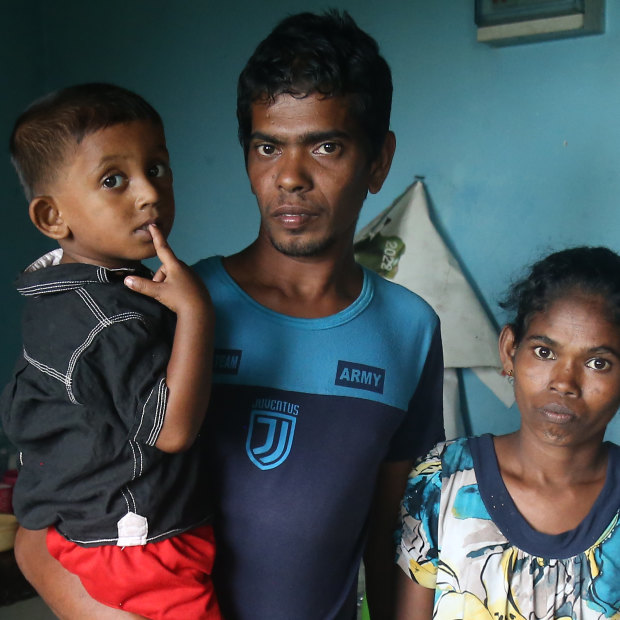
Sandun Rohitha with his wife Niluka and son Yenura. Without gas for the past eight months, they have been using firewood and plastic sheets to cook.Credit: Pradeep Dambarage
In the shanties of north-east Colombo, they called it Garbage Mountain. No ordinary rubbish dump, it soared over the suburb of Kolonnawa, rising as high as 90 metres, as 800 tonnes of rubbish from Sri Lanka’s commercial capital was unloaded at the site every day.
Five years ago, after a flood and a fire, it came crashing down, to catastrophic effect. “Suddenly we heard a really loud noise,” recalls Sandun Rohitha, who lived next to the waste pile in a home made of plastic sheets. “I had a helmet and safety jacket and I ran to the dump and pulled one man out. But I saw another one, an 18-year-old, get buried before my eyes. We were unable to get him out. I sat down and for a long time I just cried.”
Rohitha, 33, talks fast and loud in his native Sinhalese as he revisits the tragedy, which killed at least 30, his voice bouncing hard off the bare concrete walls of the Colombo flat he now shares with his wife Niluka, 38, and their son Yenura, 3. He was one of the fortunate ones that day in April 2017 as his neighbourhood was devastated. But though he relocated, life is tougher than ever.
Sri Lanka is floundering in its worst financial collapse in decades, grappling with chronic shortages of – and skyrocketing prices for – fuel, food, medicine and other essentials. It has triggered political upheaval and violence as anger has grown this year at government mismanagement of the economy, culminating on Saturday July 9 with thousands of protesters storming the residence of President Gotabaya Rajapaksa. Hundreds of men, women and children have also tried to flee the troubles on boats, mostly towards Australia.
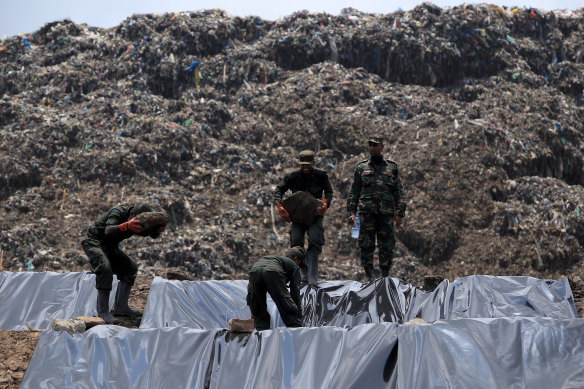
Sri Lanka soldiers at the 2017 Garbage Mountain disaster in Colombo.Credit: Getty Images
Nowhere, though, is the impact of this crisis felt more heavily than for those, like Rohitha, who were already on the fringes. The World Bank estimated in April that 11.7 per cent of Sri Lanka’s 22 million people would fall below its poverty line this year, earning less than $US3.20 ($4.60) a day. But amid rapidly rising inflation, which hit an all-time high of 39.1 per cent the following month, the state of affairs has become even bleaker. So precarious is it, in fact, that the United Nations said in June that 5.7 million citizens – a quarter of the population – were in need of immediate humanitarian assistance, with four of five people forced into coping strategies such as eating less.
The reality for the urban poor in Colombo smacks you in the face as you walk past the cattle feeding on food scraps in the street and take the creaky lift up to Rohitha’s decrepit dwelling, on the fifth floor of a 12-level block in Colombo’s eastern Singhapura district. His small two-bedroom apartment is mostly windowless and devoid of furniture aside from two wooden chairs and an old chest of drawers. His son is lying on one of the filthy mattresses they sleep on, fiddling with the smartphone he has successfully wrested from his father’s grip.
Rohitha works as the building’s sweeper, employed by Sri Lanka’s Urban Development Authority, so each day, after his boy is dropped off at the local Montessori at 8am, he sets off with his broom, cleaning floor by floor until 1pm before clearing out the drains and dumping litter. Niluka accompanies him with a broom of her own, wanting to help him despite not being paid herself. Lately, amid the regular, hours-long blackouts that have also afflicted Sri Lanka this year, Rohitha’s employer has added another task for him, as the building’s on-call elevator attendant.
“Every day there is a power cut, so when the lights go off and somebody gets stuck in the lift, I’m in charge of getting people out,” he says. When the alarm sounds, he rushes off to whatever floor they’re trapped on to release the doors with a key.
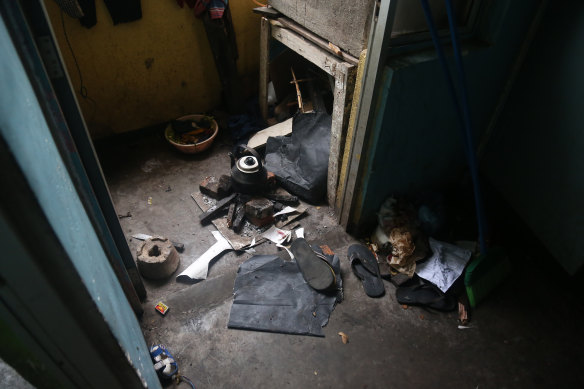
Families are limited in what they can use as domestic fuel. Credit: Pradeep Dambarage
Rohitha is paid 30,000 Sri Lankan rupees a month (worth about $220 until March, when the currency was devalued), which, while meagre, had been enough for them to get by. Now, in the grip of a crippling economic meltdown, his wage’s value has fallen to about $120 and he’s been struggling to hold on. Without gas for domestic use for about eight months, the family has been using firewood to cook in the tiny open-air space behind their kitchen. Because there has also been no kerosene available, they have been tearing off pieces of a plastic sheet to stir up the flames. It is a big fire risk, but they have no other option.
“After the gas cylinder ran out, I really started to feel what is going on,” Rohitha says. “Last week, I spent a whole day in a queue with a cylinder and I still didn’t get it refilled.”
Even with the firewood, which they collect from another rubbish disposal site, Rohitha and Niluka have been limited in what they can cook as cost-of-living pressures intensify to breaking point across the island nation. Fuel prices have increased five-fold since the start of the year, while food inflation shot up to a record 57 per cent in the 12 months to May. Not long ago, a litre of milk was 180 rupees. In June, it was priced at 430 rupees ($1.70). The cost of everything, from rice to sugar and fish, has also soared.
Rohitha is deeply religious and spiritual. Like the majority of Sri Lankans, he is Buddhist but he also worships Hindu deities, and has figurines of gods lined up on a lone shelf in his front room. Just outside his flat, above the frame of his front door, he has hung an ash pumpkin, a type of melon, from a nail by a wire. It is a traditional ritual in Sri Lanka, aimed at dispelling evil and instilling positive energy inside the home, and he has had it up, with a face of the devil painted on it, since February, when the country’s slide backwards began to accelerate.
“I can’t bear the sadness that I’m going through right now. I question why this is happening to my child and to our country.”
Rohitha reaches up and touches the ash pumpkin each time he enters or leaves the flat. Sadly, however, the good fortune he’s been searching for has been eluding him. “We used to eat well before. We ate fish and dhal but we can barely think of buying food any more,” Rohitha says. “Yesterday I was eating rice and por sambol [a Sri Lankan condiment made of coconut] and my son said, ‘Father, I’d like to eat a piece of fish.’ I can’t bear the sadness that I’m going through right now. I question why this is happening to my child and to our country.”
Sri Lanka is far from an outlier in suffering amid the volatility brought on by the COVID-19 pandemic and then Russia’s war in Ukraine. There is a global energy crisis, and the decline in food security – the ability of people to access sufficient, nutritious meals – is an escalating problem across the world.
Where the former British colony stands out, though, is in the magnitude and mode of its fall. In 2019 it was reclassified by the World Bank as an upper-middle-income economy, elevating it to the second-highest of the organisation’s four categories alongside the likes of China, Brazil and Malaysia. An emerging tourist hotpot, it attracted more than 2 million international visitors that year, including 92,000 Australians, drawn to its temples, beaches, cuisine and old-world charm.
Only three years later, it was left effectively bankrupt. In May, it defaulted for the first time on its $US51 billion ($74 billion) overseas debt and announced that, after having a stockpile of $US7.6 billion in foreign exchange reserves in 2019, it was down to its last $US50 million in usable overseas currency. Coupled with the devalued rupee, the spiral has left Sri Lanka unable to pay for imports of basic necessities, having to resort to buying oil from Russia, and a credit line from India for fuel. For a time, that allowed at least a trickle of relief.
In mid-June, however, as the last shipment from India arrived, petrol and diesel bowsers were again all but empty. The knock-on effects were far-reaching: drivers having to queue for 24 hours and more to top up; clashes with police at petrol stations; public transport threatening to grind to a halt; fishing trawlers anchored at shore; farming machinery unable to be fired up. Schools also shut down. The country suspended non-essential fuel sales on June 27 until July 10, utilising its reserves for the likes of health, law and order, and food distribution.
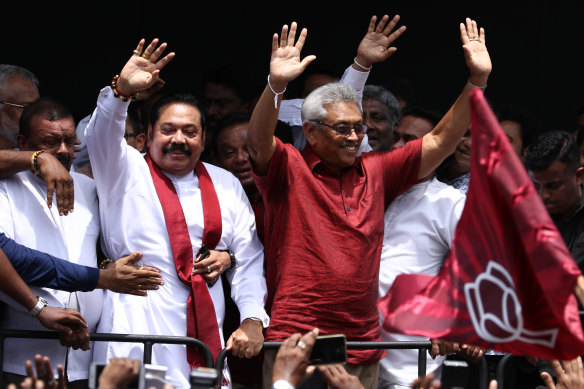
Brothers Mahinda Rajapaksa (left, the ex-PM) and President Gotabaya Rajapaksa are blamed for stoking the crisis.Credit: Getty Images
In the meantime, as the government attempted to negotiate a bailout from the International Monetary Fund and tried to restructure its debt, it has been printing money to be able to pay its more than one million public servants.
The galling aspect for Sri Lankans is that this was all largely self-inflicted and could have been avoided. Global push factors such as rising commodity prices and blocked supply chains have played their part, but analysts blame the leadership of Gotabaya Rajapaksa for a series of policy decisions that bumped the country over the edge.
Already it was loaded with high-interest Chinese debt over failed projects such as a port and airport in southern Hambantota, loans dating back to the presidency of Gotabaya’s older brother Mahinda Rajapaksa, who was in office between 2005 and 2015 and was made prime minister by Gotabaya when he returned the family to power in 2019. But the introduction of sweeping, populist tax cuts soon after Gotabaya was elected president shaved off a quarter of government revenue.
Then, last year, an ill-conceived, overnight ban on artificial fertiliser left farmers reeling, almost halving overall crop production as output of rice and tea, its number-one export, plummeted. The final ingredient was arrogance. By the time the government admitted it had a problem, it was too late.
“This crisis is very much a man-made crisis,” says Dhananath Fernando, an analyst with the Advocata Institute, a Colombo think tank. “It’s not like a natural disaster or anything like that. This crisis had been indicated very early. If we had started the process of restructuring our debt early, when we had some foreign reserves, people may not have had to go through this pain.”
Gotabaya Rajapaksa had outlined his vision for an organic transition in his presidential manifesto. He was eager to rein in the use of chemicals that had been linked to kidney disease in Sri Lanka’s central and northern provinces, where they had washed into the water supply. Quixotically, this would have made him a global leader in going organic.
However, in a nation where more than 30 per cent of people are employed in the agricultural sector, the execution was disastrous. Nimali Atukorale, a single 42-year-old farmer near Ballapana, a village 90 minutes’ drive north-east of Colombo, was floored when the ban was imposed in April last year. As urea, a key top dressing for rice paddy fields, and other fertilisers disappeared from shelves in less than a month, the remainder hoarded by those with the deepest pockets, Atukorale was forced to abandon a rice paddy she had leased after two successful harvests.
“The government told us to make our own organic fertiliser, from using dung from goats, from chicken and from cows and leaves from discarded material,” she says. “I didn’t have the means to make enough for two acres of paddy, so I left it.”
Manufacturers of organic fertilisers didn’t have the capacity to cover for chemical products coming off the market, Gotabaya Rajapaksa has since conceded, and what was provided by the government to farmers also proved nowhere near as effective. Atukorale has maintained another rice paddy in the area, afraid of losing the lease when it expires if she doesn’t, but after previously extracting 1000 kilograms of rice from it during a single harvest, it has since produced only 400 kilograms.
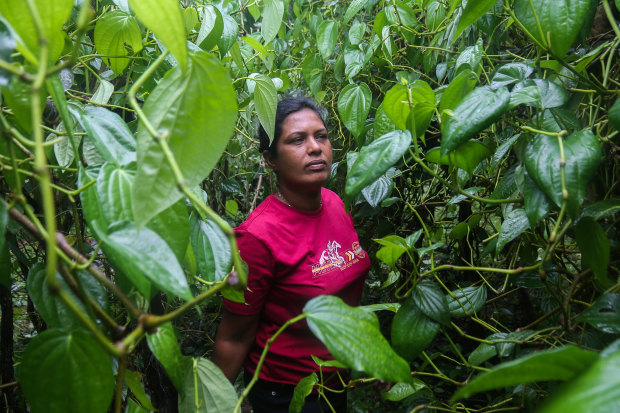
Farmer Nimali Atukorale had to abandon land she had leased after the fertiliser ban.Credit: Pradeep Dambarage
Zipping along on a motorbike on the narrow road that divides the lush landscape, she makes her way to several other plots of land where she is still attempting to cultivate pineapples and betel leaves, which are typically shipped off to Pakistan. The pineapples look sickly, having not grown properly because the right fertiliser never arrived, she says. She also holds out little hope for the betel leaves, convinced they will succumb to disease without the correct nutrients. They are so sensitive to changes in environment she won’t even apply coconut oil in her hair, as many Sri Lankan women do, when she works on that field.
Atukorale was a self-made success. She took up farming in 2015 after running a string of communication centres offering services such as photocopying and printing, and before last year had made about 100,000 rupees a month. She still scrapes together 80,000 a month (about $320), but it is worth markedly less. Even though chemical fertilisers can be used again – the ban was reversed last November – prices are eye-watering due to lack of supply. “I’m scared that I will lose even the level I’m maintaining now,” she says. “I had a target that by the age of 40 to 45, I would be doing reasonably well with farming. Now, of course, I’m absolutely lost.”
The turmoil in Sri Lanka’s food bowl highlights just why so many are struggling to feed themselves – and the forecast for the months ahead is even more grim. Vimlendra Sharan, the Sri Lanka representative of the UN’s Food and Agriculture Organisation, has predicted crop yields in this year’s
harvest to again be down by 50 per cent.
There are also increasing concerns about malnutrition and not just as a result of falling harvests. In hospital maternity wards, the exhaustion of foreign currency reserves has led to a shortage of sachets of micronutrients given to new mothers. Their absence is representative of a wider dearth of drugs and other supplies in the country’s much-vaunted public health sector, which held up pretty well during the pandemic.
At the National Hospital in Colombo, Sri Lanka’s largest, the blood bank has been running low on crucial supplies. “We have an ample amount of blood donors,” says Rajeev Menon, the 38-year-old doctor who runs the department. “You go to a village, or you go to any blood-donation camp, or you put it out on social media that we need blood for a particular thing, and more donors than you need will want to come in. But the problem is we have a limited stock of blood bags.”
Dwindling fuel resources prompted major operations to be postponed because doctors and nurses were stuck in queues at petrol stations.
As a result, packs of blood have been reserved for the most essential surgeries, and those booked for routine operations have been asked to postpone them. Hospitals have also been running out of crucial equipment such as endotracheal tubes to treat newborns and others for procedures like catheterisation. Alarmingly, dwindling fuel resources by mid-June prompted major operations such as heart surgeries to be postponed because doctors and nurses were stuck in queues at petrol stations, or taking their chances on a bus, or riding long distances to work on a bicycle. The Apeksha Hospital, Sri Lanka’s leading cancer treatment facility, warned that it risked disruption because its employees were having such difficulty showing up.

Dr Rajeev Menon, head of a Colombo blood bank, says there is a shortage not of blood donors, but of blood bags. Credit: Pradeep Dambarage
Sitting in his rundown office on the hospital’s ground floor, Menon says he always wanted to be a doctor, having idolised his father who, as a GP, was treated like a god in the remote villages he worked in. Menon trained in St Petersburg, Russia, because places in medical school were so hard to secure in Sri Lanka, but “I always had that feeling that I had to come back, to do some service for these people.”
He remains committed to the task, even though, on top of everything else, medical workers have had to swallow a cut in wages introduced in May. By Australian standards, doctors in Sri Lanka were already paid a pittance. With allowances, Menon, whose wife is also a doctor, earned about 200,000 rupees a month. Since May, 15 per cent of that has been stripped away.
After two years of the pandemic, he worries about intensifying pressure on medical staff who, on top of demands at work, are left battling to pay their mortgages and rent – or in the case of one of his employees, to even afford a three-wheeler ride to the hospital. Without an urgent restocking of medicine and equipment, the uncertainty of how patients might react also plays on his mind. “You know, they are economically burdened. They are under stress,” he says. “They come to the hospital and when we tell them that there is no medicine … definitely there will be a knee-jerk reaction.”
Leaving his house near Colombo’s town hall in jeans and joggers on May 9, it didn’t take long for Roshan Mahanama to realise this would not be a regular Sunday-afternoon walk. The World Cup-winning former Sri Lankan cricketer, a household name on the island, planned to take his usual route, north towards Beira Lake, in central Colombo, before pivoting west in the direction of the Galle Face, the city’s landmark coastal park and promenade.
That morning he had laid an advertising voiceover for an Indian company whose products fix roof leaks, and had heard that busloads of pro-government supporters were being transported into the city for a meeting at Temple Trees, the official residence of Prime Minister Mahinda Rajapaksa. The information was spot-on, but after gathering there, the loyalists then boarded the buses again and headed for the Galle Face, where the main protest site had been set up for weeks outside the office of Gotabaya Rajapaksa.
When they arrived, all hell broke loose. They attacked the demonstrators with sticks and clubs and set fire to their encampment and in response, the hitherto peaceful protesters went on a rampage themselves, torching the homes of MPs aligned with the Rajapaksas, whose family has been the dominant force in Sri Lanka for most of the past two decades and has been dogged by allegations of corruption. Amid the violence there were nine deaths, and as protesters converged on Temple Trees, PM Mahinda Rajapaksa resigned.
Striding towards Beira Lake, Mahanama, now 56, saw angry protesters burning buses which had been carrying government backers and pushing vehicles into the water. As members of the pro-Rajapaksa mob leapt into the lake themselves to take cover, he urged calm. Later, as he made his way on foot to the Galle Face, he witnessed more chaos. Only the unusual intervention of a group of lawyers, forming a line and holding hands with one another, stood between confrontation erupting between demonstrators and the police.
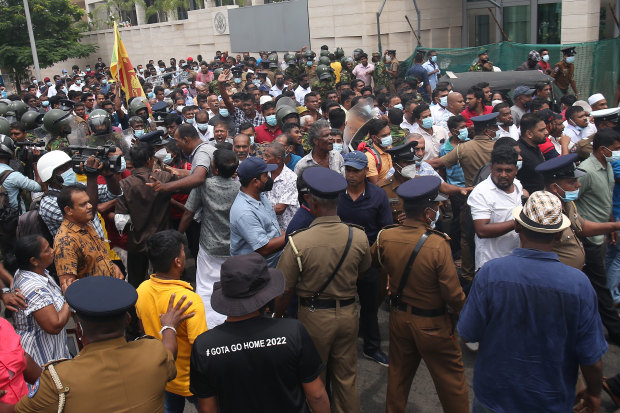
Protesters and pro-government supporters clash in Colombo on May 9, resulting in nine deaths. Credit: Getty Images
“They were so mad. People knew that these buses were coming,” says Mahanama, who played 52 Tests as a batsman and went on to oversee many
others as an international match referee. “It’s very sad. That’s the last thing you want – your own people fighting, or fighting with anyone, for that matter. You don’t want to see a bloodbath.”
In a nation where cricket is almost a religion, Mahanama had been the first
notable ex-player to attend anti-government protests this year, having voiced his support for the movement early on social media as fury with the authorities grew sharply. With a middle-class upbringing on the southern outskirts of Colombo and as a successful cricketer, he has largely been looked after by the establishment. But via the charities he’s involved in, and at his pharmaceutical distribution business, he’s seen how badly many have been hit by Sri Lanka’s downfall and felt compelled to be out on the streets.
“That’s the last thing you want – your own people fighting. You don’t want to see a bloodbath.”
“We played in an era where there was no money. It was all about the love for the sport and the pleasure of doing something for your country, and that’s why I have been down there [to the main protest site],” says Mahanama, a father of three daughters, and now a grandfather. “This is a beautiful
country and I am a very proud Sri Lankan.”
Strolling down the Galle Face with Mahanama nearly a month after the violence of early May, all is quiet except for the ever-present sound of waves crashing in from the Indian Ocean, and tuk-tuks and buses rattling along. As drivers honk their horns at him as they pass by, acknowledging his presence, he recalls having to queue for dry rations as a boy in the early 1970s amid another foreign-exchange crunch and communist insurrection.
He speaks of another flashpoint in Sri Lanka’s history he experienced as a child – the mass anti-Tamil riots of 1983 that set the scene for the 26-year civil war between the Sri Lankan military and the Tamil Tigers, who were fighting to establish a separate state in the north and east. More recently, the island endured the 2004 Boxing Day tsunami, which left more than 30,000 dead, and the Easter Sunday bombings of 2019, in which 269 people were killed in suicide bombings of churches and luxury hotels.
Sri Lankans have shown remarkable resilience, and Mahanama believes they must rally together once more. At the same time he shares the resentment which has swept across the island, admitting that the more he walks around Colombo, “the more I can’t respect the politicians”.
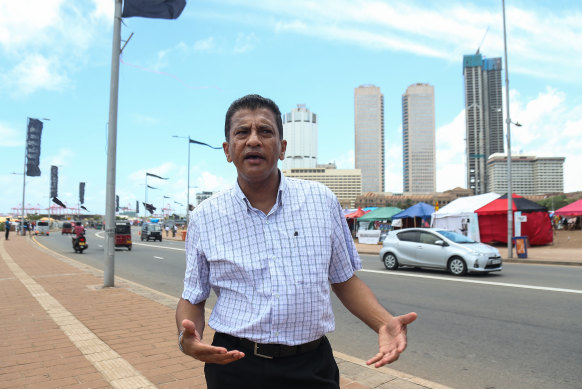
“I can’t respect the politicians,” says former Sri Lankan cricketer Roshan Mahanama.Credit: Pradeep Dambarage
Gotabaya Rajapaksa has said he won’t run again at the next presidential election in 2024 but has rejected demands for him to step down immediately, vowing to complete his five-year term. In an effort to appease protesters, the Sri Lankan cabinet in June ticked off on reforms that, if approved by two-thirds of parliament, would reduce the sweeping executive controls of the presidency. They had already been diluted in 2015 after Mahinda Rajapaksa was voted out of the top job – but in 2020, following younger sibling Gotabaya’s election victory, the might of the presidency was restored.
Furious at his refusal to budge, though, demonstrators on July 9 massed outside his official residence in Colombo and burst in. Images of protesters swimming in the president’s pool were broadcast amid reports that he had fled.
Whatever his political future, the legacy of the long-ruling clan is “finished”, according to Anush Wijesinghe, a research fellow at the Institute of Policy Studies of Sri Lanka. “This is not an ordinary scenario where people were unhappy with how they were governing and voted them out at an election,” he says. “This is people completely disgusted by their rule, feeling extremely let down by how they managed the country and the perception that they enrich their own pockets.”
Left in such a dire predicament, there is now no neat, linear path out for Sri Lanka, which has been appealing for bridging finance as the UN warned of a “full-blown humanitarian emergency”. Members of the Australian cricket team, who were due to start playing a second Test match against Sri Lanka in Galle on Friday, joined the campaign for assistance, saying they were asking friends to help in any way they could, to “hit this crisis for six”.
Away from the cricket ground, the Australian government announced $50 million of aid for urgent food, healthcare and economic recovery, and expanding cooperation with Colombo on its maritime border protection. It has watched with concern as Sri Lanka unravelled, re-energising the people-smuggling racket as boats of would-be migrants set off for Australia. The two
countries also have well-entrenched community connections, with 145,000 Sri Lankan-born people living in Australia, according to last year’s census.
In a troubled global landscape, however, it may not be easy to tug on the heartstrings of donors, so Sri Lanka is going to extraordinary lengths in a bid to help itself. Partly to combat the shortage of fuel and also to address the worsening outlook with food, public-sector employees have been given Fridays off for three months to stay at home and grow their own produce. Members of the state workforce have also been informed that they can travel abroad for work on unpaid leave for the next five years, a move designed to enable them to send cash back from overseas to the broke island.
“It seems appropriate to grant government officials leave of one working day … to engage in agricultural activities in their backyards or elsewhere as a solution to the food shortage that is expected,” a government spokesperson said in June.
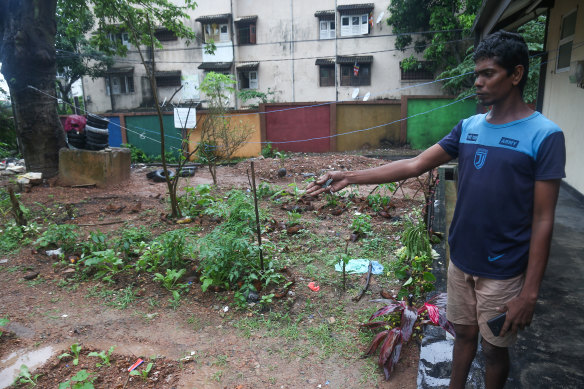
Sandun Rohitha has started growing vegetables in a sandy plot near his house: “I want my child to be in a better place than I am.”Credit: Pradeep Dambarage
Back in eastern Colombo, Rohitha has not been given Fridays off work, but a month before the directive, he decided to do the same. In his spare time, he began planting his own vegetables on a vacant patch of sandy soil near his block after gaining permission from the local authority. Upstairs, on a tiny balcony next to where he has been cooking with firewood, he has been dropping seeds of okra in plastic bottles to germinate.
Out of curiosity, he used to spread seeds around when he lived next to Garbage Mountain and watch them flourish. In the miserable circumstances he has found himself in now, he has harnessed that passion for cultivation. He has planted radishes, chillies, spinach and tomatoes – “the cows have eaten the string beans” – and even produced a Facebook video to show others how they can take advantage of such a space. A group of kids from the block have been helping him with tending to his new vegetable garden, and as they gather around to show off the fruits of their labour, grins bursting on their faces, one says: “I have drawn a picture of this.”
Unfortunately, not everyone can follow Rohitha’s example – in Colombo itself, tens of thousands of people living in flats don’t have access to even a small outdoor area to plant in. But having found one himself, he is eager to teach the children in the neighbourhood “this is necessary for the future” and that no strip of land should go to waste. “I want my child to be in a better place than I am,” he says. “I want him to know one day that I helped him to get to a good place.”
To read more from Good Weekend magazine, visit our page at The Sydney Morning Herald, The Age and Brisbane Times.